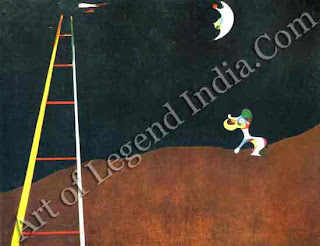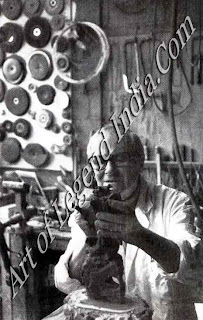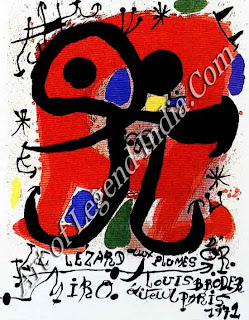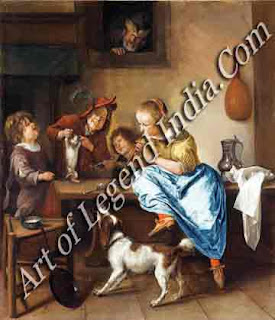 Roguish Humour
Roguish Humour
Through
patient effort, Miro evolved an art of beguiling freshness and spontaneity,
developing a highly personal language of signs and symbols and displaying his
savage delight in the absurd.
At the
beginning of the century, Barcelona, capital of Catalonia, was the cultural
centre of Spain. It was here that Miro discovered the works of the Post
Impressionists, the Fauves and the Cubists which helped to shape his early
style. But it was Catalonia's mountainous landscape where Miro's family came
from that was his greatest inspiration. In his early 'realist' paintings, he
recorded every detail of this landscape with scrupulous attention and devotion.
'What interests me above all', he wrote to a friend, 'are the tiles on the
roof, the calligraphy of a tree, leaf by leaf and branch by branch, blade of
grass by blade of grass.' While he was working on The Farm in 1921-22 a tribute
to his family house in Montroig he used to take clods of earth and grasses with
him in his suitcase when he travelled to Paris, so that the precise details
would not escape him.
But
there was also a strong element of fantasy in Miro's character, which attracted
him to the less realistic work of the early Romanesque painters who decorated
the old Catalonian chapels with frescoes of simple, brightly-coloured figures,
using distortion and a hieratic scale for symbolic or emotional effects. He
also admired the stocky painted plaster figures made by local artisans for
their lack of artistic pretension. Such things appealed to him for their naive
humour and honesty, and the tricks of distortion and of depicting important
things much larger were later assimilated into his own work.
 In
Paris, Miro was encouraged to develop his imaginative faculties by the
Surrealist poets and artists that he met. Fascinated by their experiments with
summoning up the unconscious through states of hallucination, he would sit for
hours in his studio capturing the strange sensations and forms he experienced
when hallucinating himself through extreme hunger. The artistic freedom of this
method was vital to his creative development: from the early 1920s onwards,
Miro no longer used space and colour in a realistic way to depict everyday
objects, and the forms that appeared in his paintings became a personal
language of signs and symbols.
In
Paris, Miro was encouraged to develop his imaginative faculties by the
Surrealist poets and artists that he met. Fascinated by their experiments with
summoning up the unconscious through states of hallucination, he would sit for
hours in his studio capturing the strange sensations and forms he experienced
when hallucinating himself through extreme hunger. The artistic freedom of this
method was vital to his creative development: from the early 1920s onwards,
Miro no longer used space and colour in a realistic way to depict everyday
objects, and the forms that appeared in his paintings became a personal
language of signs and symbols.
SIMPLIFYING FORMS
 Miro's
Catalan peasants became stick-like figures, for example, recognizable by their
attributes: Phrygian cap and a pipe perhaps or a wedge-shaped hunter's knife
and gun. Many of Miro's humorous figures look naive and unsophisticated, like
children's doodles, and he was deliberately trying to evolve an art that would
stimulate basic sensations of humour, fear, excitement and passion in the
spectator; to 'rediscover the religious and magic sense of things, which is
that of primitive peoples'. He developed his new figures by a process of
simplification, a stripping away of unnecessary details. 'Showing all the
details', he said, 'would deprive them of that imaginary life that enlarges everything.'
Miro's
Catalan peasants became stick-like figures, for example, recognizable by their
attributes: Phrygian cap and a pipe perhaps or a wedge-shaped hunter's knife
and gun. Many of Miro's humorous figures look naive and unsophisticated, like
children's doodles, and he was deliberately trying to evolve an art that would
stimulate basic sensations of humour, fear, excitement and passion in the
spectator; to 'rediscover the religious and magic sense of things, which is
that of primitive peoples'. He developed his new figures by a process of
simplification, a stripping away of unnecessary details. 'Showing all the
details', he said, 'would deprive them of that imaginary life that enlarges everything.'
The
same figures Catalan peasants, women and birds, ladders, stars and strange
nocturnal creatures appear over and over again in his work. The ladder, for
example, was part of the familiar clutter around the Montroig farmhouse, but
gradually it became transformed in Miro's paintings into a symbol of escape,
often leading into a night sky as in Dog Barking at the Moon (left). Woman was
usually portrayed as Mother Earth, 'to whom Mini always offers his devotion': a
symbol of fecundity as she is often shown in primitive ethnic sculptures. And
the bird, like the ladder, represents the freedom of the spirit and an escape
from mundane everyday reality. Other shapes and hieroglyphs are not so easy to
interpret, sometimes being there just to satisfy Miro's sense of balanced
composition, but they all contribute to the haunting fascination of his work.
'It is signs that have no precise meaning that provoke a magic sense', he
believed. Sometimes, these eccentric symbols are reminiscent of Chinese or
Japanese written characters, and Miro is paintings become a playful form of
calligraphy.
 Miro
felt free to distort and rearrange as his imagination dictated, and to place
anatomical forms arms, heads, breasts, hands and feet and other signs in
comical juxtapositions. Some of his paintings, like Harlequin's Carnival, are
very light-hearted and humorous, as if Miro took a childish delight in
arranging his toys, but his forms have also been described as 'torture
instruments'.
Miro
felt free to distort and rearrange as his imagination dictated, and to place
anatomical forms arms, heads, breasts, hands and feet and other signs in
comical juxtapositions. Some of his paintings, like Harlequin's Carnival, are
very light-hearted and humorous, as if Miro took a childish delight in
arranging his toys, but his forms have also been described as 'torture
instruments'.
During
the 1930s and the war years, and particularly in the Barcelona Suite of
lithographs, Miro created a nightmare world of vicious grossly distorted
monsters. His women sprouted ugly spikes of hair, claw-like nails and their
gaping mouths are filled with jagged fangs. Both his males and females, often
attacking each other, were given enormous sexual organs. Distressed and
disturbed by political events, Miro was showing man in all his bestiality and
cruelty, indulging his most destructive instinctual drives and the coarser
aspect of his humour.
Miro
had no respect for conventional aesthetic standards. Apart from the content of
his work, he often chose to use the meanest of materials, making collages and
sculptures out of cardboard and old sacking, lengths of rope, rusty nails and
bed springs, broken crockery and endless bits and pieces picked up on his
walks. Often these objects were the inspiration he needed to spark a
composition, supplying 'the shock which suggests the form just as cracks in a
wall suggested shapes to Leonardo'. Sometimes, just a splotch of colour on a
canvas, a dribble of turpentine or an escaping thread would do the same.
LASTING INFLUENCE
Miro's
influence on 20th-century artists has been enormous. His fascination with
textures and his free, spontaneous creations inspired the tachiste painters and
'action' painters like Jackson Pollock, while his strange, naive characters
were taken up by the Art Brut painters after the Second World War. His
enormously varied output, covering painting, sculpture, ceramics, collages,
etchings, engravings and lithographs, remains a continuing source of
inspiration.
Dutch Interior I
In
1928, Miro paid a brief visit to Holland, where he was intrigued by the
detailed realism of Dutch 17th-century genre paintings in Amsterdam's
Rijksmuseum. He returned to Paris with a few postcard reproductions of the
pictures he had seen, from which he painted his own series of 'Dutch
Interiors'. Dutch Interior I was based on Hendrick Sorgh's Lutanist of 1661.
Miro, however, transformed the original with the medieval logic of the
Romanesque Catalan artists, painting important things large and unimportant
things small - and sometimes removing them altogether. Instead of the lyricism
of Sorgh's picture, Miro's 'Dutch Interior' has a frenzied, dancing rhythm.
Writer
– Marshall Cavendish
 Roguish Humour
Roguish Humour  In
Paris, Miro was encouraged to develop his imaginative faculties by the
Surrealist poets and artists that he met. Fascinated by their experiments with
summoning up the unconscious through states of hallucination, he would sit for
hours in his studio capturing the strange sensations and forms he experienced
when hallucinating himself through extreme hunger. The artistic freedom of this
method was vital to his creative development: from the early 1920s onwards,
Miro no longer used space and colour in a realistic way to depict everyday
objects, and the forms that appeared in his paintings became a personal
language of signs and symbols.
In
Paris, Miro was encouraged to develop his imaginative faculties by the
Surrealist poets and artists that he met. Fascinated by their experiments with
summoning up the unconscious through states of hallucination, he would sit for
hours in his studio capturing the strange sensations and forms he experienced
when hallucinating himself through extreme hunger. The artistic freedom of this
method was vital to his creative development: from the early 1920s onwards,
Miro no longer used space and colour in a realistic way to depict everyday
objects, and the forms that appeared in his paintings became a personal
language of signs and symbols. Miro's
Catalan peasants became stick-like figures, for example, recognizable by their
attributes: Phrygian cap and a pipe perhaps or a wedge-shaped hunter's knife
and gun. Many of Miro's humorous figures look naive and unsophisticated, like
children's doodles, and he was deliberately trying to evolve an art that would
stimulate basic sensations of humour, fear, excitement and passion in the
spectator; to 'rediscover the religious and magic sense of things, which is
that of primitive peoples'. He developed his new figures by a process of
simplification, a stripping away of unnecessary details. 'Showing all the
details', he said, 'would deprive them of that imaginary life that enlarges everything.'
Miro's
Catalan peasants became stick-like figures, for example, recognizable by their
attributes: Phrygian cap and a pipe perhaps or a wedge-shaped hunter's knife
and gun. Many of Miro's humorous figures look naive and unsophisticated, like
children's doodles, and he was deliberately trying to evolve an art that would
stimulate basic sensations of humour, fear, excitement and passion in the
spectator; to 'rediscover the religious and magic sense of things, which is
that of primitive peoples'. He developed his new figures by a process of
simplification, a stripping away of unnecessary details. 'Showing all the
details', he said, 'would deprive them of that imaginary life that enlarges everything.'
 Miro
felt free to distort and rearrange as his imagination dictated, and to place
anatomical forms arms, heads, breasts, hands and feet and other signs in
comical juxtapositions. Some of his paintings, like Harlequin's Carnival, are
very light-hearted and humorous, as if Miro took a childish delight in
arranging his toys, but his forms have also been described as 'torture
instruments'.
Miro
felt free to distort and rearrange as his imagination dictated, and to place
anatomical forms arms, heads, breasts, hands and feet and other signs in
comical juxtapositions. Some of his paintings, like Harlequin's Carnival, are
very light-hearted and humorous, as if Miro took a childish delight in
arranging his toys, but his forms have also been described as 'torture
instruments'. 











0 Response to "Spainish Great Artist Joan Miro - Roguish Humour"
Post a Comment